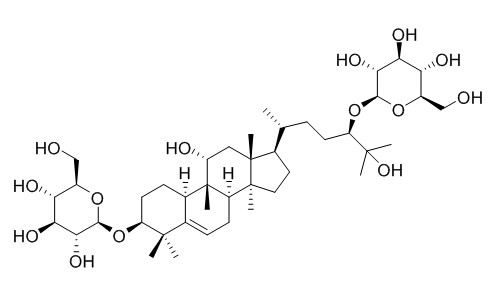Mogroside IIe
Mogroside IIe is a bitter triterpenoid saponin which is the main component of unripe Luo Han Guo fruit and a precursor of the commercially available sweetener mogroside V.
Inquire / Order:
manager@chemfaces.com
Technical Inquiries:
service@chemfaces.com
Tel:
+86-27-84237783
Fax:
+86-27-84254680
Address:
1 Building, No. 83, CheCheng Rd., Wuhan Economic and Technological Development Zone, Wuhan, Hubei 430056, PRC
Providing storage is as stated on the product vial and the vial is kept tightly sealed, the product can be stored for up to
24 months(2-8C).
Wherever possible, you should prepare and use solutions on the same day. However, if you need to make up stock solutions in advance, we recommend that you store the solution as aliquots in tightly sealed vials at -20C. Generally, these will be useable for up to two weeks. Before use, and prior to opening the vial we recommend that you allow your product to equilibrate to room temperature for at least 1 hour.
Need more advice on solubility, usage and handling? Please email to: service@chemfaces.com
The packaging of the product may have turned upside down during transportation, resulting in the natural compounds adhering to the neck or cap of the vial. take the vial out of its packaging and gently shake to let the compounds fall to the bottom of the vial. for liquid products, centrifuge at 200-500 RPM to gather the liquid at the bottom of the vial. try to avoid loss or contamination during handling.
BMC Plant Biol.2023, 23(1):239.
Heliyon2020, 6(6):e04337.
J Agric Food Chem.2020, 68(51):15164-15175
Int J Mol Sci.2020, 21(7):2530.
J Nat Med.2020, 74(1):65-75
J Food Drug Anal.2023, 31(2):254-277.
Phytomedicine2022, 104:154318
Life Sci.2021, 270:119074.
Food Res Int.2020, 128:108778
Biomolecules.2019, 9(11):E696
Related and Featured Products
Molecules. 2014 Aug 20;19(8):12676-89.
Cucurbitane glycosides derived from mogroside IIE: structure-taste relationships, antioxidant activity, and acute toxicity.[Pubmed:
25140446]
Mogroside IIe is a bitter triterpenoid saponin which is the main component of unripe Luo Han Guo fruit and a precursor of the commercially available sweetener mogroside V.
METHODS AND RESULTS:
In this study, we developed an enzymatic glycosyl transfer method, by which bitter Mogroside IIe could be converted into a sweet triterpenoid saponin mixture. The reactant concentration, temperature, pH and buffer system were studied. New saponins with the α-glucose group were isolated from the resulting mixtures, and the structures of three components of the extract were determined. The structure-taste relationships of these derivatives were also studied together with those of the natural mogrosides. The number and stereoconfiguration of glucose groups present in the mogroside molecules were found to be the main factor to determine the sweet or bitter taste of a compound. The antioxidant and food safety properties were initially evaluated by their radical scavenging ability and via 7 day mice survival tests, respectively.
CONCLUSIONS:
The results showed that the sweet triterpenoid saponin mixture has the same favorable physiological and safety characteristics as the natural mogrosides.
Chem Pharm Bull (Tokyo). 2006 Oct;54(10):1425-8.
Cucurbitane glycosides from unripe fruits of Lo Han Kuo (Siraitia grosvenori).[Pubmed:
17015982]
METHODS AND RESULTS:
From the unripe fruits of Lo Han Kuo (Siraitia grosvenori), a Chinese medicinal plant, two new cucurbitane triterpene glycosides, 20-hydroxy-11-oxomogroside IA(1) (1) and 11-oxoMogroside IIe (2), were isolated along with five known cucurbitane glycosides, 11-oxomogroside IA(1) (3), Mogroside IIe (4), mogroside III (5), mogroside IVA (6), and mogroside V (7), and two flavonoid glycosides, kaempferol 7-O-alpha-L-rhamnopyranoside (8) and kaempferol 3,7-di-O-alpha-L-rhamnopyranoside (9).
CONCLUSIONS:
Their structures were determined on the basis of detailed analyses of 1D, 2D-NMR spectroscopic methods and by comparing with literature values. This paper describes the first investigation of unripe bitter Lo Han Kuo fruits.



